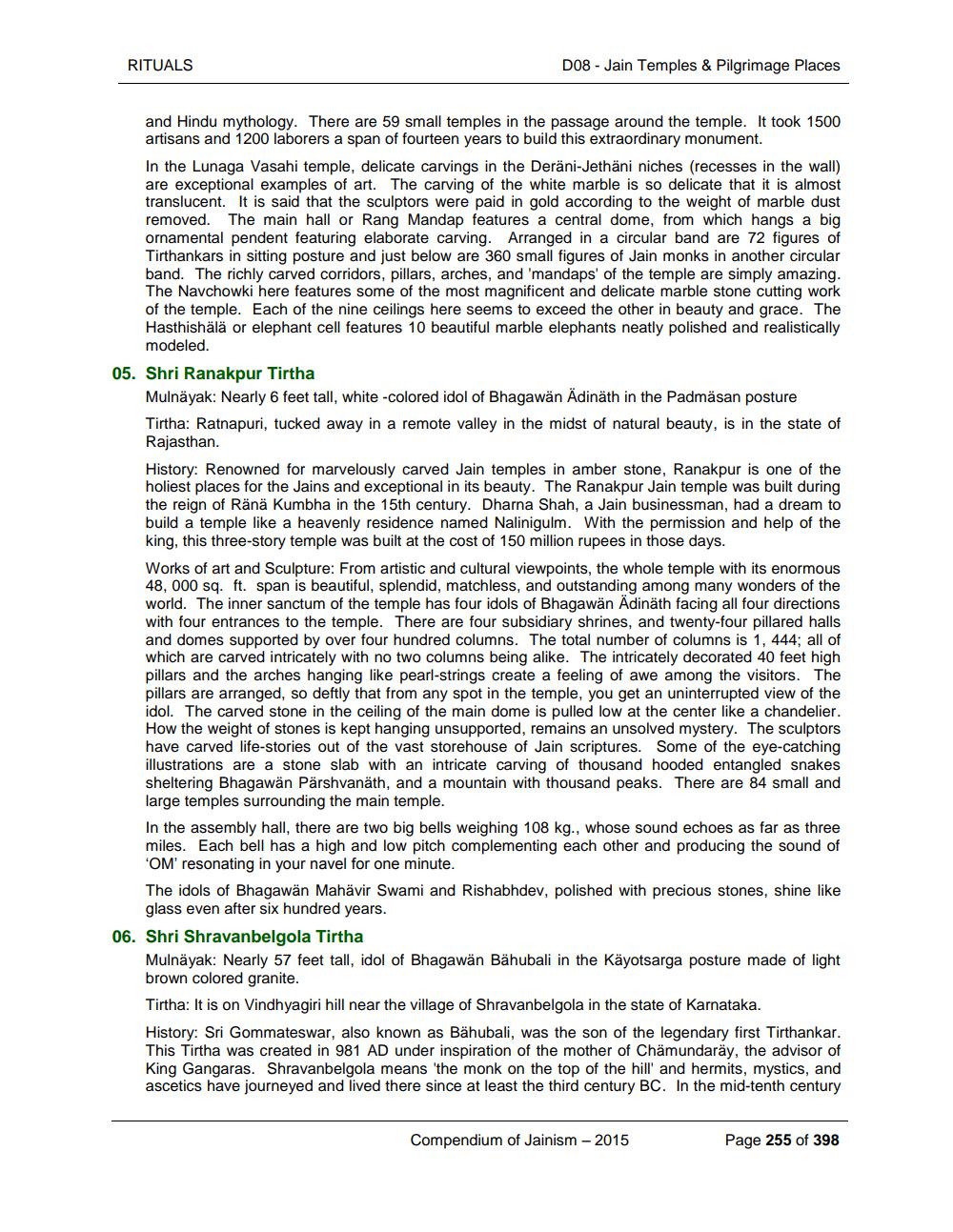________________
RITUALS
D08 - Jain Temples & Pilgrimage Places
and Hindu mythology. There are 59 small temples in the passage around the temple. It took 1500 artisans and 1200 laborers a span of fourteen years to build this extraordinary monument. In the Lunaga Vasahi temple, delicate carvings in the Deräni-Jethäni niches (recesses in the wall) are exceptional examples of art. The carving of the white marble is so delicate that it is almost translucent. It is said that the sculptors were paid in gold according to the weight of marble dust removed. The main hall or Rang Mandap features a central dome, from which hangs a big ornamental pendent featuring elaborate carving. Arranged in a circular band are 72 figures of Tirthankars in sitting posture and just below are 360 small figures of Jain monks in another circular band. The richly carved corridors, pillars, arches, and 'mandaps' of the temple are simply amazing. The Navchowki here features some of the most magnificent and delicate marble stone cutting work of the temple. Each of the nine ceilings here seems to exceed the other in beauty and grace. The Hasthishälä or elephant cell features 10 beautiful marble elephants neatly polished and realistically
modeled. 05. Shri Ranakpur Tirtha
Mulnayak: Nearly 6 feet tall, white -colored idol of Bhagawan Adinath in the Padmasan posture Tirtha: Ratnapuri, tucked away in a remote valley in the midst of natural beauty, is in the state of Rajasthan. History: Renowned for marvelously carved Jain temples in amber stone, Ranakpur is one of the holiest places for the Jains and exceptional in its beauty. The Ranakpur Jain temple was built during the reign of Ränä Kumbha in the 15th century. Dharna Shah, a Jain businessman, had a dream to build a temple like a heavenly residence named Nalinigulm. With the permission and help of the king, this three-story temple was built at the cost of 150 million rupees in those days. Works of art and Sculpture: From artistic and cultural viewpoints, the whole temple with its enormous 48, 000 sq. ft. span is beautiful, splendid, matchless, and outstanding among many wonders of the world. The inner sanctum of the temple has four idols of Bhagawan Adinath facing all four directions with four entrances to the temple. There are four subsidiary shrines, and twenty-four pillared halls and domes supported by over four hundred columns. The total number of columns is 1, 444; all of which are carved intricately with no two columns being alike. The intricately decorated 40 feet high pillars and the arches hanging like pearl-strings create a feeling of awe among the visitors. The pillars are arranged, so deftly that from any spot in the temple, you get an uninterrupted view of the idol. The carved stone in the ceiling of the main dome is pulled low at the center like a chandelier. How the weight of stones is kept hanging unsupported, remains an unsolved mystery. The sculptors have carved life-stories out of the vast storehouse of Jain scriptures. Some of the eye-catching illustrations are a stone slab with an intricate carving of thousand hooded entangled snakes sheltering Bhagawan Pärshvanath, and a mountain with thousand peaks. There are 84 small and large temples surrounding the main temple. In the assembly hall, there are two big bells weighing 108 kg., whose sound echoes as far as three miles. Each bell has a high and low pitch complementing each other and producing the sound of 'OM' resonating in your navel for one minute. The idols of Bhagawan Mahävir Swami and Rishabhdev, polished with precious stones, shine like
glass even after six hundred years. 06. Shri Shravanbelgola Tirtha
Mulnäyak: Nearly 57 feet tall, idol of Bhagawan Bahubali in the Käyotsarga posture made of light brown colored granite. Tirtha: It is on Vindhyagiri hill near the village of Shravanbelgola in the state of Karnataka. History: Sri Gommateswar, also known as Bahubali, was the son of the legendary first Tirthankar. This Tirtha was created in 981 AD under inspiration of the mother of Chamundaräy, the advisor of King Gangaras. Shravanbelgola means 'the monk on the top of the hill' and hermits, mystics, and ascetics have journeyed and lived there since at least the third century BC. In the mid-tenth century
Compendium of Jainism - 2015
Page 255 of 398




